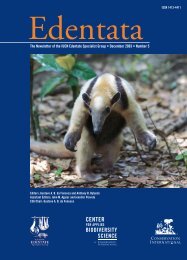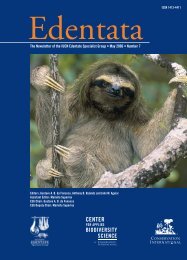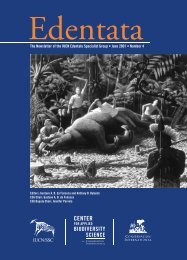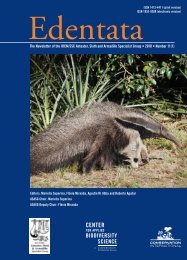Edentata 11(2), 2010 - Anteater, Sloth & Armadillo Specialist Group
Edentata 11(2), 2010 - Anteater, Sloth & Armadillo Specialist Group
Edentata 11(2), 2010 - Anteater, Sloth & Armadillo Specialist Group
- No tags were found...
Create successful ePaper yourself
Turn your PDF publications into a flip-book with our unique Google optimized e-Paper software.
Chaetophractus villosusLeast Concern (LC)Photograph: Kevin Schafer, www.kevinschafer.comCommon Names: Large hairy armadillo (English),peludo (Spanish).Assessment Rationale: C. villosus is listed as Least Concernin view of its wide distribution, presumed largepopulation, its presence in a number of protectedareas, its tolerance of a degree of habitat modification,and because it is unlikely to be declining fast enoughto qualify for listing in a threatened category.Geographic Range: It is present in the Gran Chacoof Bolivia, Paraguay, and Argentina and as far southas Santa Cruz, Argentina and Magallanes, Chile(Fig. 12). It has been introduced in Tierra del FuegoProvince, Argentina (Poljak et al., 2007; Poljak etal., <strong>2010</strong>). It ranges from sea level up to 1,500 masl (Argentina). The extent of occurrence is approximately2,525,000 km 2 but no information is availableon the area of occupancy.Population: This is one of the most common armadillospecies in Argentina (Abba, 2008).savanna, and forest habitats. It is also found in cultivatedlandscapes (Abba et al., 2005; Abba et al., 2007;Abba, 2008) and some degraded habitats (arable land,pastureland, rural gardens, and plantations). Malesand females reach sexual maturity at one year of age,and the female gives birth to one yearly litter of oneto three young. Gestation length is 68 days.Threats: In general, there appear to be no majorthreats to this species. In some parts of its range itis locally used for food and charangos (Aguiar andFonseca, 2008). It is also persecuted as a pest speciesin agricultural areas, and is subjected to sport hunting.Animals may also be killed on roads and by dogs(Abba et al., 2007; Abba, 2008).Conservation: This species is present in many protectedareas.Assessors: Abba, A.M. and Superina, M.Evaluators: Bolkovic, M.L. and Poljak, S.Habitats and Ecology: C. villosus is present in a widevariety of grasslands (including pampas and chaco),152<strong>Edentata</strong> no. <strong>11</strong>(2) • <strong>2010</strong>














